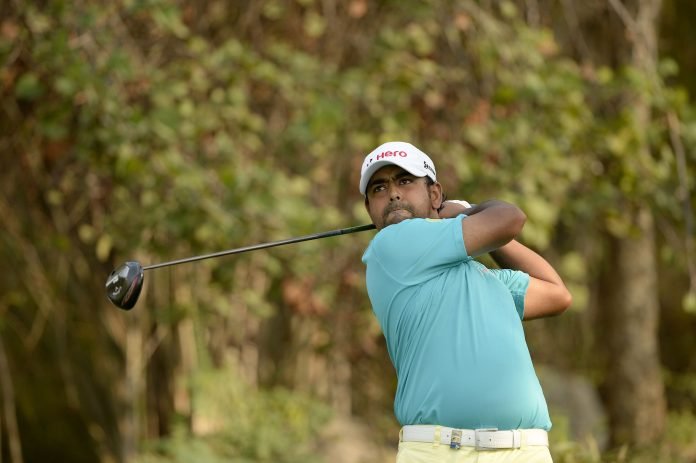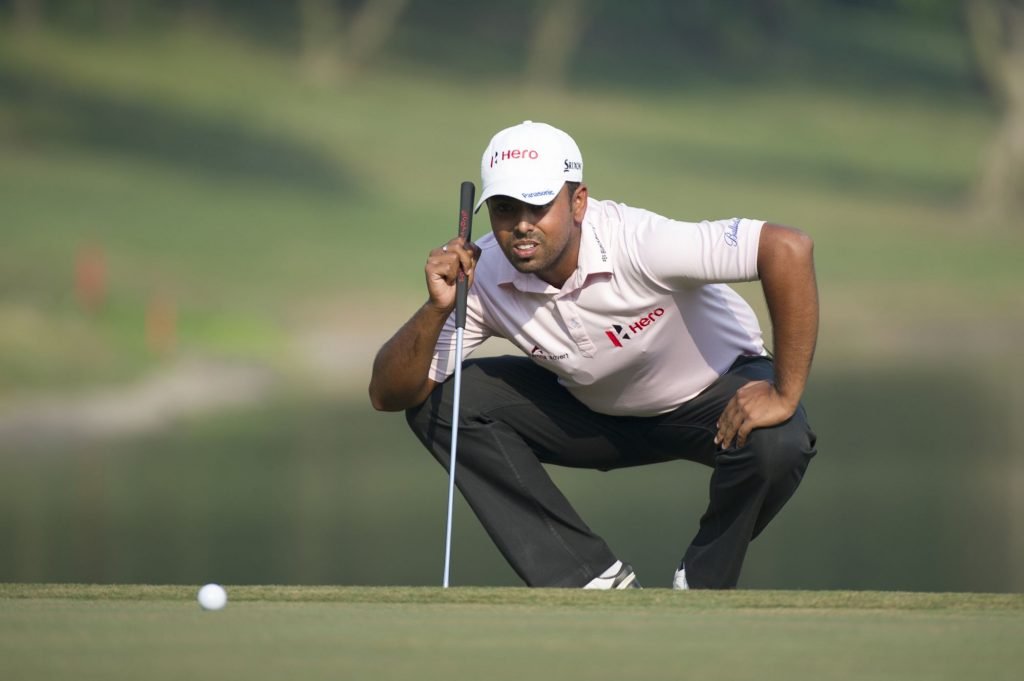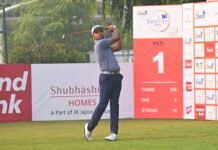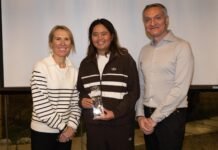
Moderator: We’d like to welcome Anirban Lahiri to this virtual interview. Just to start off looking ahead of this week’s John Deere Classic, give us your thoughts about how your game feels this week ahead of the tournament.
Anirban: My game is feeling quite good. This is probably the best I’ve felt since my bout with COVID. I think I had a lot of positives in the one week, and then last week also I played some good golf. I played some average golf, but there was a lot of positives. This week I’ve tried to work on some of those areas that needed a little bit of polishing, and I’m excited. I like the golf course. Weather is going to be nice and warm, which is something that I usually like.
You have something to share with the Indian media who we’re delighted to have on board with us for this call. Why don’t you go ahead and share what you have in your mind.
Anirban: I just basically wanted to share my personal story or my personal experience obviously with COVID, something that has changed all our lives. I just wanted to bring a little bit of awareness in this part of the world, and I’m really appreciative of the fact that the PGA Tour is helping me to get the word out. Obviously as an Indian citizen, being so far away from home, seeing what’s been happening has been difficult to watch; having friends, family, people that we know and love have their lives affected, torn apart, it’s a very difficult time for the world. But certain parts of the world, I think more people are affected in very severe ways than others.
Also a few people have spoken to me and asked me about my own experience and what it was like, so I also wanted to share what I went through. It just so happened that when my coach came in from India, he actually tried to avoid exposing himself at the airport, and he actually went to a friend’s house in Delhi when he was transiting. I’m going back to early April. And when he landed here and we started work, the day after he landed, the friend he stayed with called us and said that he was not feeling well.
The stars kind of aligned in a way where he unfortunately contracted the virus even though he was fully vaccinated, and I kind of got it from him the week of Hilton Head, and so did my family, my wife. I think my daughter had it, too, even though we didn’t test her because she’s only two years old.
And then I had a pretty serious bout with it. I had a fever — you know, the usual symptoms, but they were kind of prolonged. On the fifth day I was asked to go to the urgent care by my doctor, and I was still in Hilton Head, and at that point in time they actually diagnosed me with COVID pneumonia, which was quite a scary thing to hear and to deal with and wrap our heads around.
The chest X-rays were not very positive, so that’s when I started on stronger and slightly different medication. Again, I felt very fortunate that I had access to that kind of care. I had access to medication. I know that at that same point of time in India a lot of people were going through what I was going through didn’t even have that, and a lot of the families and a lot of the people I spoke to, how helpless they felt.
Fortunately for me, three days later I had to go back — well, fortunate or unfortunately for me I had to go back to the emergency room and I was admitted for about three or four hours because my fever broke 104, and this was the ninth day, so it was unusually bad. My oxygenation came down, and my doctor was a little worried for me.
Went back to the ER, and then fortunately when they did a subsequent chest X-ray and subsequent tests they ruled out COVID pneumonia, which was a big relief. That’s probably the most dangerous thing that would happen to an athlete.
Then the slow process of recovery started. I lost 15 pounds or about seven and a half kilos in 10 days. I lost pretty much all of my muscle mass that I had built up over the last eight, ten months of training pre-COVID, lost a lot of the speed and lost a lot of time because obviously I missed out on playing quite a few events.
Then even coming back, it took me two weeks just to be able to play golf again afterwards, and thereafter it took me a further two weeks to start playing competitive golf that was worthy of being on the PGA Tour. So I lost almost a month, month and a half.
Through all of this, I was very fortunate that my wife didn’t have a very serious case. She got a mild case. I was so bad that she actually had to drive down from Palm Beach to Hilton Head seven hours while she had COVID to come and take care of us because she was the only person who could have had access to us.
It was a very difficult time for the family. I think when someone has COVID, the person is more or less unable to do much, but it’s probably the family members who feel the most helpless. I saw that same amount of — that same feeling in my wife and what she had to go through.
At the same time, the second wave started in a very bad way in India late April and May, and obviously we’ve had struggles of our own which most of us are aware of, some of the people out west are probably not as aware of.
I just wanted to share my story. I wanted to sort of bring awareness. Also we’ll be doing some other interactions, I will be doing some other interactions with the PGA Tour to kind of get that message out, and yeah, I think the whole idea was just to bring that awareness to the golfing audience, especially this part of the world, and encourage them to kind of help and donate as much as possible to some of the Indian charities.
You know, that was it. And also just sharing my own personal story. It’s been exactly two months actually, because May 4th or May 3rd I think was when I was technically asymptomatic or I got rid of my symptoms and I was fully recovered. So it’s been exactly two months since I got back on my feet.
I’m fighting my way back. Not the easiest place in the world to come back after these kind of challenges, but I’m proud of the way that I’m facing up to whatever is in front of me. A lot of people out there who don’t have a lot going on in their life, not a lot of positivity, and I just want them to believe when the time comes and the opportunity comes, they can rise and do what they need to do.
Also Read: Making a difference for Anirban is Olympics in India colours
Q. You were just saying that you had sort of a big battle with COVID and it really traumatized you. At the same time before that also the form was kind of lean. Now you’re on the road to recovery, your game is coming back slowly, you finished sixth in Texas. In that sense are you heading into a big stretch like the Olympics in a good frame of mind with a lot of that momentum that every athlete sort of craves for?
Anirban: I’d like to believe that. But I think just — it’s been a very strange 12, 13 months for everyone, of course, but even for me personally from a professional standpoint, I use the word “stuck” but actually I wasn’t. I was in India two and a half months last year during the lockdown, which was a very important phase for me in my career and my game to kind of reorganize myself. I came back, and I played really well last fall in whatever opportunities I got.
Like you mentioned, in 2021 I got off to a poor start and kind of bled that form away. I had to work very hard after that to get my confidence back, and I started playing much better. Like you mentioned, I finished fifth in Texas, and I was building that momentum, and then COVID struck.
It’s been a case of me getting momentum, losing it, getting momentum, losing it, getting momentum, and now I find myself on another sort of wave that I’m beginning to gather some momentum.
The idea is going to be to obviously stay fit and healthy but also to keep building that because you can’t borrow momentum or generate it instantaneously. It takes a few weeks. It takes a few good results. Right now I feel like, like I said, I’m feeling healthy and strong.
You know, the Olympics is something that — well, I feel like it was a blessing to me. It wasn’t something that was on the agenda, but now that I have the opportunity, I don’t want to make the same mistakes I made in Rio because I was injured in Rio. Now I have a few events building up to it, so I have a lot to do here, and I’m just trying to build it, trying to keep my head down and stick to what I need to do.
Q. I wanted to ask you, how’s it been receiving the news on Udayan Mane who you’ve played with a lot growing up, you have a lot in common from training under the same coach. What has the discussion been because he mentioned to us that you’ve been talking to each other a lot on the phone?
Anirban: Yeah, I’ve been talking to him a lot. I was very happy and excited for him. I think unofficially when Emiliano pulled out — in fact, it was two weeks ago and I went and had a chat with Emiliano myself just to make sure that he was serious about what he was saying, and then I spoke to Udayan and kind of confirmed it on my end, as well.
I’m very excited. Look, it’s going to be a life-changing experience for him. He’s still in his early stage of his professional career. Obviously a great player, great potential. Like you mentioned, I’ve known him for almost 15 years now already, have kind of seen him develop from when he was a junior into a very good amateur and now into a consistent professional on the PGTI, and hopefully he can keep moving forward to the higher tours, maybe even join me one day here.
I’ve just been trying to guide him through some of the processes. As professional golfers we get used to doing things our way. We get used to a certain routine and a certain habit and approaching events in a certain way, and then when you have an event — a bigger event like the Olympics, it’s just completely different. There are so many different authorities involved. You have the Indian Olympic Association, you have the Sports Authority of India, you have the Indian Golf Union, of course you have the International Golf Federation and you have Tokyo 2020, as well, as an organizing body. So there are so many different aspects, lots of different angles, and for someone like Udayan who was also not expecting it and finds out with barely three, four weeks to go, it’s been a bit overwhelming.
So as a senior and as a friend I’ve tried to guide him, and as someone who’s gone through the process myself, I’ve just tried to keep him focused on what he needs to do and how he needs to play his best and try and stay away from all the other things that come with an event like this, the other noise and the other distractions. That’s about it.
I’m really happy, very happy that India is going to be fully represented in the men’s event. Hopefully I can correct what I felt like I couldn’t do last time, and obviously Mane being with me, it’ll be nice. Also having my dear friend, my little brother Chikkarangappa caddying for me is also something that I’m looking forward to. We’ll have three of us there, all we just are students, all motivated with the same goal, which is to bring glory to our country.
Q. (On the restrictions at the 2021 Tokyo Olympics)
Anirban: You know, I think it’s our own choice how we respond to that. It’s very simple. In a way I think it’s probably a good thing because it can be very — your first Olympic experience can be very overwhelming.
It’s obviously a very special experience, no doubt, just putting on your India tricolor track suit and walking into a stadium and watching other Indian athletes compete and try their heart out and cheer them on is a big part of it.
Unfortunately to a large extent that’s going to be missing this year, but the way I look at it is given what we need to do, it’s going to be around a 90-minute drive from the Olympic Village to the golf course. I mean, I’m there for precisely seven, seven and a half days. Really it doesn’t give us too many windows of opportunity to do anything else.
Also personally speaking, where I find myself with what I need to do on the PGA Tour, I have to utilize my time and energy efficiently.
The way I look at it is it’s probably going to keep our focus a little narrower and keep us with our eyes on what we are there to do, and I think it might actually work to our advantage, definitely to my advantage because I will use something like that and try and make it into a positive thing, which allows me to play my best, because ultimately that’s the only reason I’m going is so that I can go there, play my best and vie for a medal. Anything else is just a distraction.
Q. I wanted to ask you specifically about your experience of the previous Olympics. What is the learning that you will take to the Tokyo games? Also how is it in a way different from all the other competitions in the sense everybody that are going to be professionals in other sports, also, but then the Olympics is always different, the pressures are always different. What does it take to actually do well there?
Anirban: I think the dynamics are very different. For one, I mentioned the Olympic experience is not like anything else. To some extent that might be a little different this year given the conditions, but in terms of actually playing the tournament, there are maybe two or three differences. One is that you’re playing a smaller field. There’s only going to be 60 of us.
The second thing is you’re always going to play a golf course that you’ve never played before more than likely, unless the host nation is one of the stronger golfing nations.
The other thing is when we play professional golf, professional golf is four days of stroke play, same format, but the difference is I’m going into this week into a PGA TOUR event, but if I finish fourth, it’s still a good result. It’s still something that I will take back with me and will use next week.
I think the biggest difference, like you said, about the Olympic pressure is you don’t get anything for coming fourth. It’s a race to the podium, and it’s a bit of a sprint. Even though it’s a four-day event, you have to be more aggressive. I think you have to go slightly — it’s more of all or nothing because that’s really what you are there for, and I think that’s what the biggest difference is in golf, because if you look at a lot of the other sports, it works in the same fashion. If you finish in the top three, whether it’s swimming, whether it’s any of these other disciplines, but in golf that’s not the case. You can have a top 10, which is considered a good result, or you can have a top 25, which is called a decent result, but at the Olympics a top 25 means nothing and a top 10 could be equally insignificant.
I think the biggest change in dynamic is how you approach the week and also how you deal with the environment because it’s very different from what we do week in and week out.
Also Read: Surprised Anirban books Olympic spot
Q. I just wanted to ask you a two-part question. How difficult was that decision, or the moment you got in you knew that you were going because of the way you are positioned on the PGA Tour? And can you tell me something about your schedule? How many tournaments are you missing, and what does it do to your PGA Tour career?
Anirban: Well, what it does to my career we’ll find out in about a month, but I can answer the rest of the question. It was a very difficult but a very easy decision. Even though it sounds contradictory. The first part of it was a lot of excitement. There was a lot of surprise, definitely. And then I actually took some time by myself quietly. I kind of just sat by myself and I thought about it, and I asked myself a few questions, personal questions, which were along the lines of why do I play this game, what is the objective, what do I want to achieve as a golfer, what do I want to achieve as — what would I personally like to achieve. There are lots of things. I want to win a major, I want to win on this TOUR, I want to do so many things. It’s endless. Everybody wants a lot of different things, but I definitely want to make a difference. I definitely want to be an Olympic medallist, not just for myself but for a lot of other reasons which we all know. We’ve all talked about it over and over again.

Given where I stand in the FedExCup, that decision was harder than I would have thought, but it was always going to be that I was going to go. There was no way — I called my wife and we had this conversation. In fact, when my coach was here two months ago before the Olympic cutoff and I was very close, I was first alternate, second alternate, first alternate. We had multiple conversations and we just decided we’ll cross the bridge when I get there and let’s focus on what I need to do. Quite honestly that’s where I find myself even now.
But then when it did come to pass, I had a chat with my wife, she asked me the same question because she knew how hard it was. But I can’t live with myself if I have the opportunity to change the way people look at golf in my country.
Q. The second question was regarding your game right now. It’s a really — we can see a lot of difference in your driving. That was something you were really struggling with last year even, and this year your driving has been on the ball. You’ve been driving the ball really well. A player really knows when he’s playing well and when he’s close to doing something extraordinary. Do you feel like that, because your putting seems to be all right right now?
Anirban: I think to answer your question, my driving has been the cornerstone whenever I’ve played well. If you look at how I played last year in the fall where I played consistently, the one aspect of my game that stood out was actually my driving. So I know that whenever that part of my game is in good shape, it sets me up to actually do damage on the golf course.
Last week I struggled a lot with my wedges, which is usually something that I’m good at, so early this week, yesterday and the day before yesterday, I put in quite a few hours specifically working on — between 70 to 150 hours. Even this week at the John Deere Classic you’re going to hit a lot of wedges. It’s another golf course where unless the conditions are severe, you’re going to get a lot of birdies, much like last week.
I’m just trying now to tighten up the game. Like you said, there are lots of good things happening, but there’s enough average things happening for the score to kind of be average. I’m trying to clean it up and take inventory of some of the departments that let me down, especially last week.
These are some of the things that happen when you play two, three, four weeks in a row, and that’s not something I’ve done in a while post-COVID. My schedule was one week on, one off, one week on, one off. Now that I find myself in a three-, four-week stretch I think it’s actually easier for me to build that momentum that I spoke about earlier.
I think this is the best way for me to kind of keep improving and keep building on the good things and kind of cleaning up on the not-so-good things. Like you said, you never expect things to happen when extraordinary things happen, but you can always see a trend that this person is doing the right things, and I feel like I am.
Text courtesy: PGA Tour/Eurosport
ReadMore:- Viktor Hovland as wide eyed from time he got on to PGA Tour




